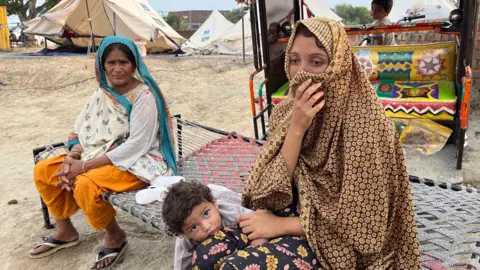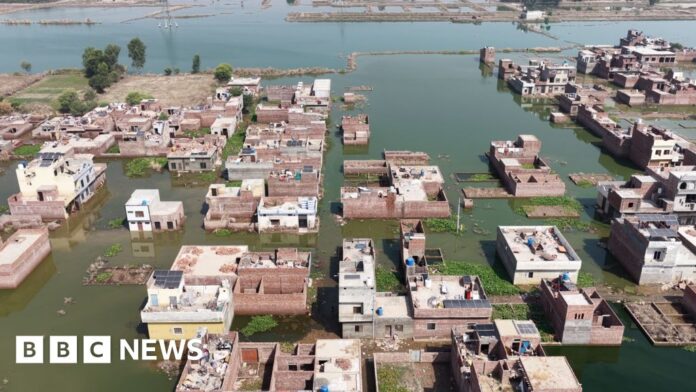Azadeh MoshiriPakistan Correspondent
 BBC
BBCRescuers and relatives searched knee-deep in water for the body of one-year-old Zara. She’d been swept away by flash floods; the bodies of her parents and three siblings had already been found days earlier.
“We suddenly saw a lot of water. I climbed up to the roof and urged them to join me,” Arshad, Zara’s grandfather, said, showing the BBC the dirt road where they were taken from him in the village of Sambrial in northern Punjab in August.
His family tried to join him, but too late. The powerful current washed away all six of them.
Every year, monsoon season brings deadly floods in Pakistan.
This year it began in late June, and within three months, floods had killed more than 1,000 people. At least 6.9 million were affected, according to the United Nations agency for humanitarian affairs, OCHA.
The South Asian nation is struggling with the devastating consequences of climate change, despite emitting just 1% of global greenhouse gas emissions.
To witness its effects, the BBC travelled from the mountains of the north to the plains of the south for three months. In every province, climate change was having a different impact.
There was one element in common, though. The poorest suffer most.
We met people who’d lost their homes, livelihoods and loved ones – and they were resigned to going through it all again in the next monsoon.
Lakebursts and flash floods

Monsoon floods started in the north, with global warming playing out in its most familiar form in Pakistan-administered Gilgit-Baltistan.
Amid the high peaks of the Himalayas, Karakoram and Hindu Kush, there are more than 7,000 glaciers. But due to rising temperatures, they are melting.
The result can be catastrophic: meltwater turns into glacial lakes which can suddenly burst. Thousands of villages are at risk.
This summer hundreds of homes were destroyed and roads damaged by landslides and flash floods.
These “glacial lake outbursts” are hard to warn against. The area is remote and mobile service poor. Pakistan and the World Bank are trying to improve an early warning system, which often doesn’t work because of the mountainous terrain.
Community is a powerful asset. When shepherd Wasit Khan woke up to rushing waters, with trailing chunks of ice and debris, he ran to an area with a better signal. He began warning as many villagers as he could.
“I told everyone to leave their belongings, leave the house, take their wives, children and elderly people and get away,” he told BBC Urdu’s Muhammad Zubair.
Thanks to him, dozens were saved.
The danger took a different form in the north-western province of Khyber Pakhtunkhwa.
In Gadoon, the BBC found hundreds of villagers digging through piles of rocks with their bare hands.
A cloudburst had caused a flash flood early in the morning, a local official said. That happens when a sudden updraft in humid, moist air leads to a heavy and localised burst of rain. The current washed away several homes and triggered a landslide.
Men from neighbouring villages rushed over to help, which was invaluable – but not enough. The excavators the villagers desperately needed were trapped in flooded roads, some blocked by massive rocks.
“Nothing will happen until the machines arrive,” one man told the BBC.
Then a silence suddenly blanketed the area. Dozens of men stood still in one corner. The bodies of two children, soaked in dark mud, were pulled from under the rubble, and carried away.

Scenes like this played out across the province, with rescuers delayed due to uprooted trees and major infrastructure being destroyed. A helicopter carrying aid crashed in the bad weather, claiming the lives of all crew on board.
Building on Pakistan’s floodplains
In villages and cities, millions have settled around rivers and streams, areas prone to flooding. Pakistan’s River Protection Act – which prohibits building within 200 ft (61m) of a river or its tributaries – was meant to solve that issue. But for many it’s simply too costly to settle elsewhere.
Illegal construction makes matters worse.
Climate scientist Fahad Saeed blames this on local corruption and believes officials are failing to enforce the law. He spoke to the BBC in Islamabad, next to a half-built, four-storey concrete building as big as a car park – and right by a stream that he saw flood this summer, killing a child.

“Just a few kilometres from parliament and still such things happen in Pakistan,” he says, visibly frustrated. “It’s because of misgovernance, the role of the government is to be a watchdog.”
Former climate minister Senator Sherry Rehman, who chairs the climate committee in Pakistan’s Senate, calls it ”graft”, or simply “looking the other way” when permissions are given for construction in vulnerable areas.
The country’s breadbasket submerged
By late August, further south in the province of Punjab, floods had submerged 4,500 villages, overwhelming “Pakistan’s breadbasket”, in a country that can’t always afford to import enough food.
For the first time, three rivers – the Sutlej, Ravi and Chenab – flooded simultaneously, triggering the largest rescue operation in decades.
“It was the most important anomaly,” said Syed Muhammad Tayyab Shah, the chief risk officer for the National Disaster Management Authority (NDMA).
In Punjab’s capital, Lahore, the impact on wealthier and poorer communities was stark. The gated community of Park View City was inundated by the Ravi river, making its prized streets impossible to navigate. Residents of luxury homes were forced to evacuate.
Surveying the damage, two local men, Abdullah and his father Gulraiz, were convinced water would be drained soon, thanks to the area’s property developer Aleem Khan, a federal minister.
“No problem, Aleem Khan will do it,” Gulraiz told the BBC.
But for residents in the poorer neighbourhood of Theme Park, the floods were crushing. One officer told the BBC they kept having to rescue people who swam back to their homes when the water levels dropped, desperate to salvage whatever they could. But then the water would rise, leaving them stranded.
We saw one man returning from his house, an inflatable donut resting on his hip.

Some residents were moved to tents provided by the Alkhidmat Foundation Pakistan. Sitting outside in the summer heat, Sumera was weeks away from giving birth. She was extremely thin.
“My doctor says I need two blood transfusions this week,” she said as she tried to keep hold of her toddler, Arsh.
Nearby, Ali Ahmad was balancing a small kitten he rescued from the floods on his shoulder. The boy was one of the few who had a mattress to sleep on.
By the end of monsoon season, the floods had displaced more than 2.7 million people in Punjab, the UN said, and damaged more than one million hectares of farmland.
Further south in Multan district, always hit hard by floods, the scale of the humanitarian crisis became even clearer, with tents lining dirt roads and highways.
Access to healthcare was already a challenge in rural areas of Pakistan, but once the floods hit, the challenge was unbearable for many women we met.
BBC Urdu’s Tarhub Asghar met two sisters-in-law, both nine months pregnant. A doctor had warned them they weren’t drinking enough water. They raised a bottle to explain. The water was completely brown.
The search for solutions

Some are trying different solutions.
Architect Yasmeen Lari has designed what she calls “climate-resilient houses” in dozens of villages. In Pono, near Hyderabad, women showed the BBC huts they’d built themselves – a large circular building on wooden stilts. Dr Lari calls it their training centre and says families can move their belongings there and shelter.
But Dr Lari argues building an entire village on stilts would be unfeasible and too expensive. Instead, she says her designs ensure the roofs don’t collapse, and that by using natural materials such as bamboo and lime concrete, the homes can be rebuilt quickly by the villagers themselves.
Pakistan has reached a point where “it’s not about saving buildings; it’s about saving lives,” she says.
This is the reality for Pakistan. All the climate scientists and politicians the BBC spoke to warn of an increasingly worrying future.
“Every year the monsoon will become more and more aggressive,” Syed Muhammad Tayyab Shah at the NDMA said. “Every year, there will be a new surprise for us.”
As the country faces the growing and ever-changing challenges posed by climate change, in which the poorest are often the worst affected, there is one refrain from people returning to homes likely to flood next year: “I have nowhere else to go.”



